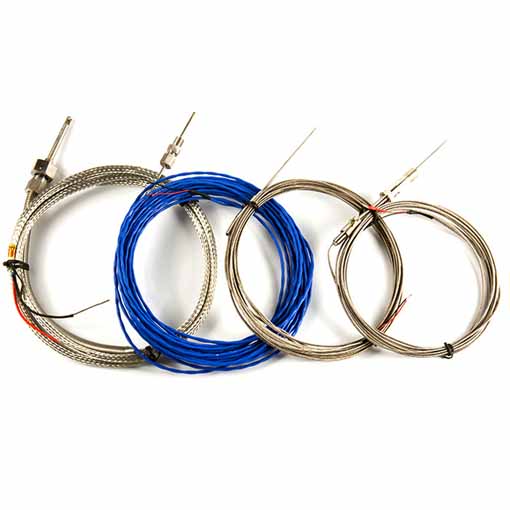产品类别
产品标签
精密热电偶供应商
原厂制造的E, J, T热电偶传感器用于以下温度检测: 温度计, 热水器, 壁炉, 炉, 电路, 实时数据, 冷端, 烤箱, 万用表, 数字的, 工业的.
E的工作原理, J, T热电偶传感器 :
当有两个不同的导体或半导体A和B形成循环时, 两端相互连接, 只要两个连接处的温度不同. 一端的温度为t, 称为工作端或热端, 另一端的温度为T0, 称为自由端 (也称为参考端) 或冷端. 循环中将产生电动力. 电动力的方向和大小与导体的材料和两个连接的温度有关. 这种现象称为 “热电效应”, 由两个导体组成的循环称为 “热电偶”. 这两个导体被称为 “热电极”, 并且产生的电动力称为 “热电动力”.
热电电力由电动力的两个部分组成, 一个部分是两个导体的接触电动力, 另一部分是单个导体的热电动力.
e热电学力的大小, J, T热电偶传感器环仅与导体材料的温度和组成热电偶的两个连接, 并且与热电偶传感器的形状和大小无关. 当固定热电偶传感器的两个电极材料时, 热电电力是两个连接温度T和T0功能的差异.
就是:
这种关系已被广泛用于实际温度测量. 因为冷交界T0是恒定的, E由E产生的热电动力, J, T热电偶仅随热连接的温度而变化 (测量端), 那是, 一定的热电子力对应于一定温度. 只要我们使用测量热电动力的方法,我们就可以实现温度测量的目的.
热电偶温度测量的基本原理是,两个不同组件的两个导体形成封闭环. 两端有温度梯度时, 电流将通过循环. 此时, 两端之间有电动力 - 托马电磁力, 这是所谓的塞贝克效果. 两个具有不同组分的同质导体是热电极, 温度更高的结尾是工作端, 温度较低的结尾是自由端, 自由端通常处于一定恒定的温度下. 根据热电动力与温度之间的功能关系, 制作热电偶索引表;
当自由端温度在0℃时获得索引表, 和不同的热电偶传感器具有不同的索引表.
当第三个金属材料在热电偶电路中连接时, 只要材料的两个连接处的温度相同, 热电偶产生的热电势将保持不变. 那是, 它不受循环中第三金属的访问的影响. 所以, 当热电偶测量温度时, 测量仪器可以连接, 在测量热电动力之后,可以知道测得的培养基的温度. 当热电偶测量温度时, 冷连接的温度 (测量端是热端, 通过铅连接到测量电路的末端称为冷连接) 保持相同温度需要. 它的热电潜力与测得的温度成正比. 如果是 (环境) 在测量过程中冷连接的温度变化, 它将严重影响测量的准确性. 采取某些措施在冷路处进行补偿, 冷连接温度变化所引起的影响称为热电偶的冷连接补偿是正常的. 专用补偿金属线用于与测量仪器连接.
热电偶传感器冷连接补偿的计算方法:
从毫伏到温度: 测量冷连接温度, 将其转换为相应的毫伏值, 将其添加到热电偶的毫伏值, 并计算温度;
从温度到毫伏: 测量冷端温度的实际温度, 分别, 用毫伏, 减去派生的MV值后, 获得温度.
原厂制造的E, J, T热电偶传感器用于以下温度检测: 温度计, 热水器, 壁炉, 炉, 电路, 实时数据, 冷端, 烤箱, 万用表, 数字的, 工业的.

铠装热电偶直径3mm + J型插座

Pt100 e, J, T温度传感器探测

热跑者热电偶温度传感线

高温K型快速热电偶
联系我们
等待您的电子邮件, 我们将在短时间内回复您 12 小时提供您需要的有价值的信息.
 English
English العربية
العربية Български
Български 粤语
粤语 中文(简体)
中文(简体) 中文(漢字)
中文(漢字) Nederlands
Nederlands Suomi
Suomi Français
Français Deutsch
Deutsch Ελληνικά
Ελληνικά Magyar
Magyar Italiano
Italiano 日本語
日本語 한국어
한국어 Polski
Polski Português
Português Română
Română Русский
Русский Slovenščina
Slovenščina Español
Español Svenska
Svenska ภาษาไทย
ภาษาไทย Türkçe
Türkçe Tiếng Việt
Tiếng Việt

